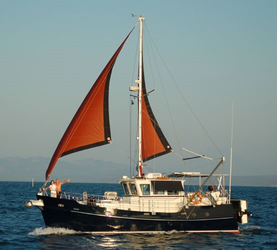Work smarter not harder! Maybe I'm getting soft in my modestly old age but working in 90 degree + conditions kicks my butt! So we added air conditioning to the wood shop. Pretty simple install that involved popping out a window and replacing it with some OSB. 72 and sunny year round, I love it!
Not much I can do about the 112 degrees it was in the boat shed this past Saturday. As I've said, if I get out early enough, open the doors and get the fan going, it's tolerable. However, I had to work early on Saturday so I didn't get out to the shop until mid afternoon. By that time it's to late so I began work on the keel bolts.
I ordered hot rolled steel rod, pre-cut in 48" and 36" lengths from an online steel supplier. Delivery charges were under $28 dollars and the total ended up being around $175 for approximately 25 pieces of steel in 5/8" and 1/2" sizes.
The keel is through bolted at each station through the floor timbers and the entire thickness of the keel. Since each one is a unique length and some are almost 4' long, these aren't bolts that you can buy off the shelf. Each will need to be custom made, cut to length, threaded and then galvanized.
I've never threaded steel rod before but online it looks really easy! I remember threading galvanized pipe at our cottage for a new water service when I was a kid and it was quite straight forward. I still have my grandfathers pipe vice, which is at least 80 years old. It's very heavy duty and worked well holding the rod securely. However the threading of 5/8" rod is not quite as easy as I thought.
The directions indicated to use a file to chamfer the edge of the rod to help with getting the threads started. However you really need an aggressive bevel for this to be effective and a file was not cutting it. I turned to the bench grinder to get an approximately 1/2" bevel machined to the end of the rod. Once I figured that part out, the process went much easier. I used a light weight oil designed for threading and tapping but it still required quite a bit of muscle to cut the threads. I threaded one end of 5 pieces before I called it a day. The threads on the other end will have to wait until the rods are cut to their final length once the keel is complete. My plan is to take advantage of random times when I have a few minutes and thread 1 end of each piece of rod. Once you understand the process it's actually quite fun to see the threads develop as you cut the steel away.
Work continues on the keel glue up as well. We are down to one remaining glue up before the main keel assembly is complete.
I noticed that their was a twist developing in the lower keel assembly. No matter how hard you try, wood moves and there is no way around it. I stole an idea from Doug Jackson over at SV Seeker and used some bottle jacks to pull the entire assembly flat against the building cradle during one of the glue ups. Since I know the building cradle is dead flat, I figured that holding the keel tightly to that would help straighten things out. The idea worked great and eliminated nearly all of the twist giving me a nice flat and plumb keel.
The only down side is I made these super clamps out of wood and they were designed for a fixed dimension, which I could not adjust. I wanted to do the same thing for the next two glue ups so I did a little more research. I found an item at home depot that fit the bill perfectly, punched steel plate. These steel plates are about an inch wide and come in lengths of 48 and 36 inches. Each one has regularly spaced holes along it's entire length. This allowed me to come up with a fully adjustable super clamp.
Even though I had taken the twist out of the first assembly I didn't want to give it a chance to twist again, so on the next glue up I applied 4 upgraded super clamps along the length of the keel to keep it nice and flat. Worked perfectly!
So now we have only 1 more glue up and it should be the easiest one yet. One glue line, two sub assemblies and then we can start adding the other keel components.
I've been neglecting the frames as we pushed to get the keel done. My job has not been boat building friendly and we've only had a few hours here and there. However work will continue and we are down to just four more frames to build!
Thanks for checking out are project and keep an eye out for our next video installment of the Sea Dreamer Project on YouTube.














No comments:
Post a Comment